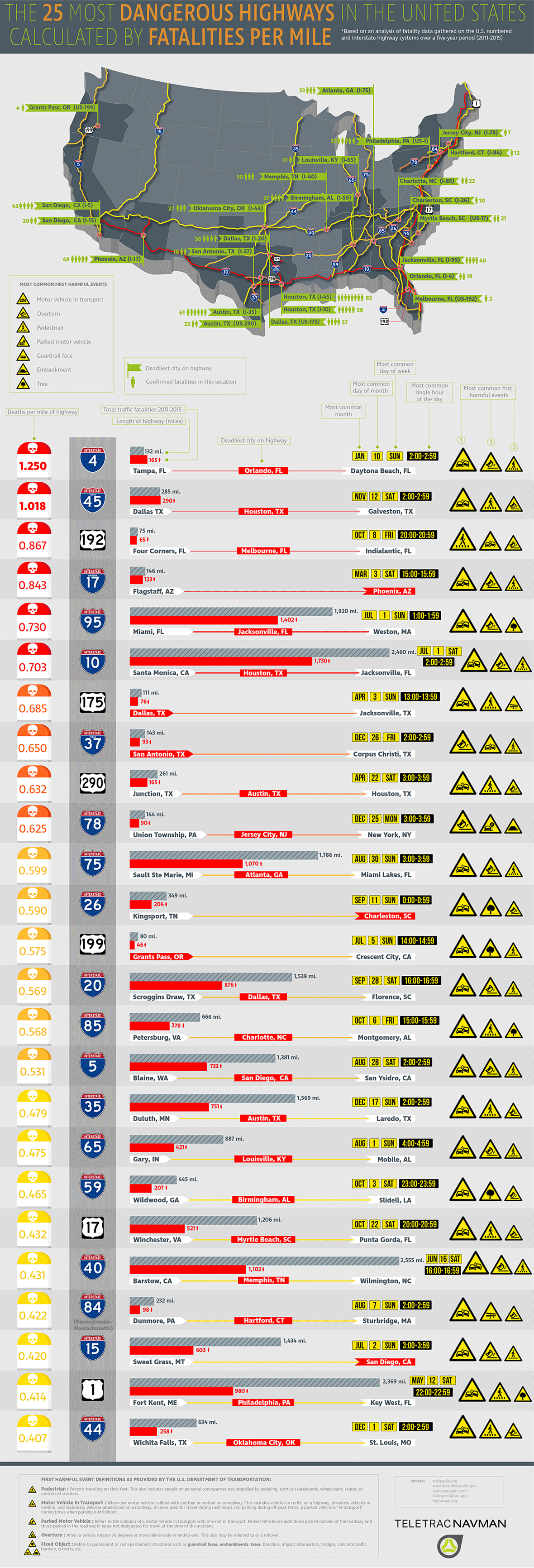Latest Texas statistics on fatal car accidents
Texas has more total lane miles than any other state in the country (679,917 miles) and while there’s no shortage of beautiful scenery when driving in Texas, the Lone Star State is also home to some of the deadliest roads and highways in the nation.
In 2019 for example, according to the Texas Department of Transportation:
- Single vehicle, run-off-the-road crashes resulted in 1,161 deaths in 2019. This was 32.16% of all motor vehicle traffic deaths in 2019.
- In 2019 there were 731 people killed in crashes occurring in intersections or related to an intersection.
- There were 600 people killed in head-on crashes in 2019.
- There were no deathless days on Texas roadways in 2019.
- There was one crash that resulted in 6 or more fatalities in 2019.
- Wednesday, June 5th and Saturday, December 7th was the deadliest day in 2019 with 21 persons killed in traffic crashes. December was the deadliest month with 333 persons killed.
- Based on reportable crashes in 2019, 1 person was killed every 2 hours 26 minutes.
What are the deadliest roads and highways in Texas?
Let’s take a look at the 7 deadliest roadways and highways in the Lone Star State based on an analysis of fatality data gathered by Teletrac Navman, a global telematics company, over a five-year period (between 2011 and 2015):
Interstate 45, located entirely within the state of Texas, is the deadliest highway in the state and also one of the nation’s most dangerous roads. I-45, which connects the cities of Dallas, Houston, and Galveston, saw 83 deaths between 2011 and 2015. The highway’s death per mile rate is 1.018.
Interstate 35 is the country’s central highway that runs through seven states, including Texas. There were 61 fatalities on I-35 in Austin over the five-year period, while the highway’s death-per-mile rate stood at 0.479.
As the deadliest highway in America, Interstate 10 stretches from California to Florida, but about a third of its length is within the Lone Star State. In Houston alone, there were 58 traffic deaths on I-10 with the death-per-mile rate of 0.703.
U.S. Highway 175 is entirely within the state of Texas. Authorities recorded 37 confirmed fatalities on U.S. Route 175 in Dallas between 2011 and 2015. The highway’s death-per-mile rate was 0.685.
Interstate 20 stretches straight through the heart of Texas. Dallas is the deadliest city on the highway that saw 36 deaths over the studied period. Interstate 20 had a death-per-mile rate of 0.569.
U.S. Route 290 is another highway located completely within Texas. U.S. 290 is the main freeway between Austin and Houston. From 2011 to 2015, 22 people died on the stretch of the highway in Austin. U.S. Route 290 had a death-per-mile rate of 0.632.
I-37 is located within the southern portion of Texas. The highway connects Corpus Christi and San Antonio. Interstate 37 in San Antonio had 18 traffic deaths over the five years, with a death-per-mile rate of 0.650.
What makes these roads and highways in Texas so dangerous?
The following factors make the above-mentioned highways the deadliest in the Lone Star State:
- Traffic congestion – these highways present more opportunities for accidents to occur due to the high numbers of drivers.
- Traveling at high speeds – accident severity tends to increase with the vehicle’s speed as traveling at higher speeds results in less time to brake safely, and less time to safely maneuver road obstacles.
- Texting while driving – regrettably, the increased accident risk that results from high speeds and high traffic numbers doesn’t deter many highway drivers from using their phones while steering.
- Inadequate infrastructure design – sometimes, cities, municipalities, and other government entities are to blame for crashes caused by inadequate road design.
- Adverse weather conditions – bad weather conditions, including rain, snow, sleet, and ice, can contribute to vehicle crashes.
- Poor road conditions – these include potholes, large cracks, and other defects and hazards resulting from the government entity’s failure to maintain the roadway in good condition.
- Equipment failure, breakdown, or malfunction – breakdowns become even more dangerous on high-velocity highways where there’s less time to brake safely and increased congestion means there’s less room to navigate around other drivers in an effort to pull over onto the road shoulder.
Deadliest highway in Texas - 285
Route 285 is a relatively remote road that runs through Pecos, Texas, and Carlsbad, New Mexico. It is also known as “Death Highway.” In 2018, 93 people died on Route 285. Texas has allocated millions to improve the road because it was originally built in the 1920s for rural traffic, and currently thousands of drivers cross it every day.
Speak with an experienced Houston car accident attorney
If you or your loved one was injured on one of the deadliest highways in Texas listed above or any other road in the Lone Star State, speak with an experienced Houston car accident lawyer to help you recover damages for your injuries. Schedule a consultation with Johnson Garcia LLP to review your case today.



